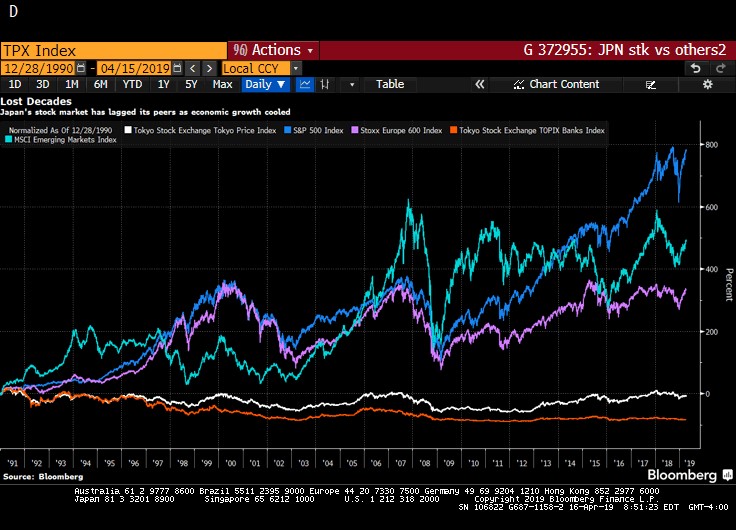As 'Japanifcation' Spreads, These Moves Will Keep You One Step Ahead
 |
Japanification.
I don’t know if you’ve heard this new market buzzword. But chances are the trends it describes are already impacting your portfolio. And if I’m right, they’ll continue to do so in the rest of 2019 and beyond. That means you should take steps to insulate your wealth right away!
Here’s the basic concept: Japan’s economy and markets were the envy of the world in the latter half of the 1980s. Stocks and real estate there soared in value. In fact, at the height of the boom, economists estimated the 0.44 square miles of land that the Imperial Palace in Tokyo sits upon exceeded the value of all the land in California (approx. 164,700 square miles).
But then the bubble burst. Real estate prices collapsed. The stock market crashed. The banking sector imploded. And the economy sank.
Policymakers threw a little bit of everything at the problems in the years that followed. Massive fiscal stimulus. Tax cuts. Zero percent interest rates, then negative rates.
Yet a long period of anemic growth, on-and-off recessions, deflation, and dramatic market underperformance persisted nonetheless. Japan was said to have experienced a “Lost Decade” ... even though the malaise ultimately lasted for much longer than 10 years.
Just look at this chart. It shows the relative performance of the Tokyo Stock Exchange (in white) and the TOPIX banks Index in Japan (in red) versus the S&P 500 (in blue), the Stoxx Europe 600 Index (in purple) and the MSCI Emerging Markets Index (in light blue). You can see that Japanese markets wildly underperformed other global markets throughout the 1990s, 2000s, and 2010s.
 |
|
Source: Bloomberg
|
Now, investors and economists are worried that “Japanification” is spreading to Europe. It’s easy to see why ...
Like the Bank of Japan, the European Central Bank hasn’t been able to stimulate the economy effectively with 0% (or sub-zero) interest rates – and hasn’t been able to raise them in years. Like Japanese banks, European banks remain saddled with large piles of non-performing loans and mountains of debt. Like Japan, Europe is facing growth constraints tied to demographic issues (an aging population). And like Japan, Europe isn’t having much success pushing inflation or inflation expectations higher.
Those are just some of the reasons why European investments are now faring so poorly for U.S.-based investors. The iShares MSCI Europe Financials ETF (EUFN, Rated “D+”) has dropped 12.5% over the past year ... the iShares MSCI Germany ETF (EWG, Rated “D+”) has shed 11.8% ... the iShares MSCI Italy Capped ETF (EWI, Rated “C-”) has sunk 11.5% ... and the iShares MSCI France ETF (EWQ, Rated “C”) has slipped 3.1%. That compares poorly to the 10.6% rise in the SPDR S&P 500 ETF (SPY, Rated “C+”) over the same time period.
So, what should you do as an investor to combat Japanification?
1. Favor domestic over foreign investments, particularly those in Japan or Europe. This is precisely what I’ve been doing in my Safe Money Report, with favorable results. In fact, my subscribers just had the opportunity to grab high-teens profits on two, domestically focused natural gas and electric utility companies.
2. Underweight financials and overweight Steady Eddie consumer staples. Japanese financial stocks were terrible performers during the last couple of decades, and European financials have been dramatic laggards the last couple of years. Consumer-focused names with solid, steady growth and more-generous dividend yields fared much better.
Economic conditions may be different here than in Europe. But we’ve seen a similar performance split in our market, with the Financial Select Sector SPDR Fund (XLF, Rated “C”) flat over the past year and the higher-yielding Consumer Staples Select Sector SPDR Fund (XLP, Rated “B-”) up more than 9%. I think that divergence will persist, and that you should position yourself to profit.
3. Maintain a relatively cautious stance. It’s easy to get swept up in the moment with the S&P 500 and Dow Industrials trading closer to their old highs. But it’s worth noting that we haven’t seen as much participation or breadth in this run as you’d expect, particularly from smaller stocks.
Consider: The iShares Russell 2000 ETF (IWM, Rated “C”) owns smaller stocks with an average market cap of $2.4 billion (versus $49 billion for the S&P 500). It was recently going for around $157, almost 10% below its peak.
The iShares Micro-Cap ETF (IWC, Rated “C-”) targets even smaller names – companies with an average market cap of $650 million – and it’s performing even worse. The ETF was recently trading around $94.50, leaving it 14% below its old high.
Our own, proprietary Weiss Ratings BUY/SELL ratio data is also showing this trend. It has bounced off its recent lows. But it remains far below the levels we saw at the January and September 2018 peaks in the large-cap-dominated averages.
My advice: With sentiment giddy and resistance at old highs a challenge to overcome, continue to focus on stocks with high Weiss Ratings, strong individual fundamentals, and attributes that allow them to prosper even in a more challenging global environment. And continue to maintain an elevated allocation to cash.
That approach has worked out very well for my Safe Money subscribers and should continue to do so in 2019 and beyond! If you’re interested in joining them, just click here.
Until next time,
Mike Larson

